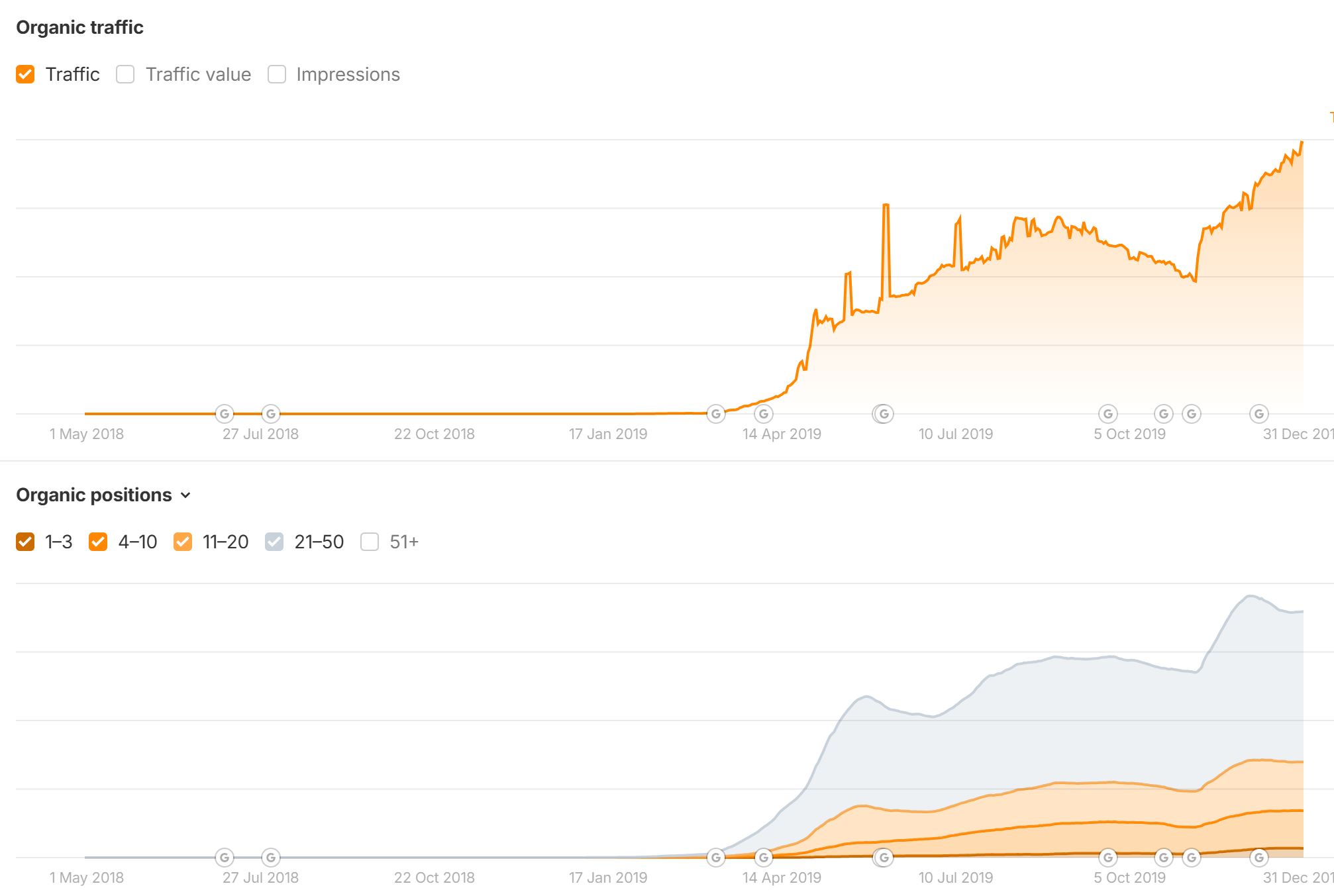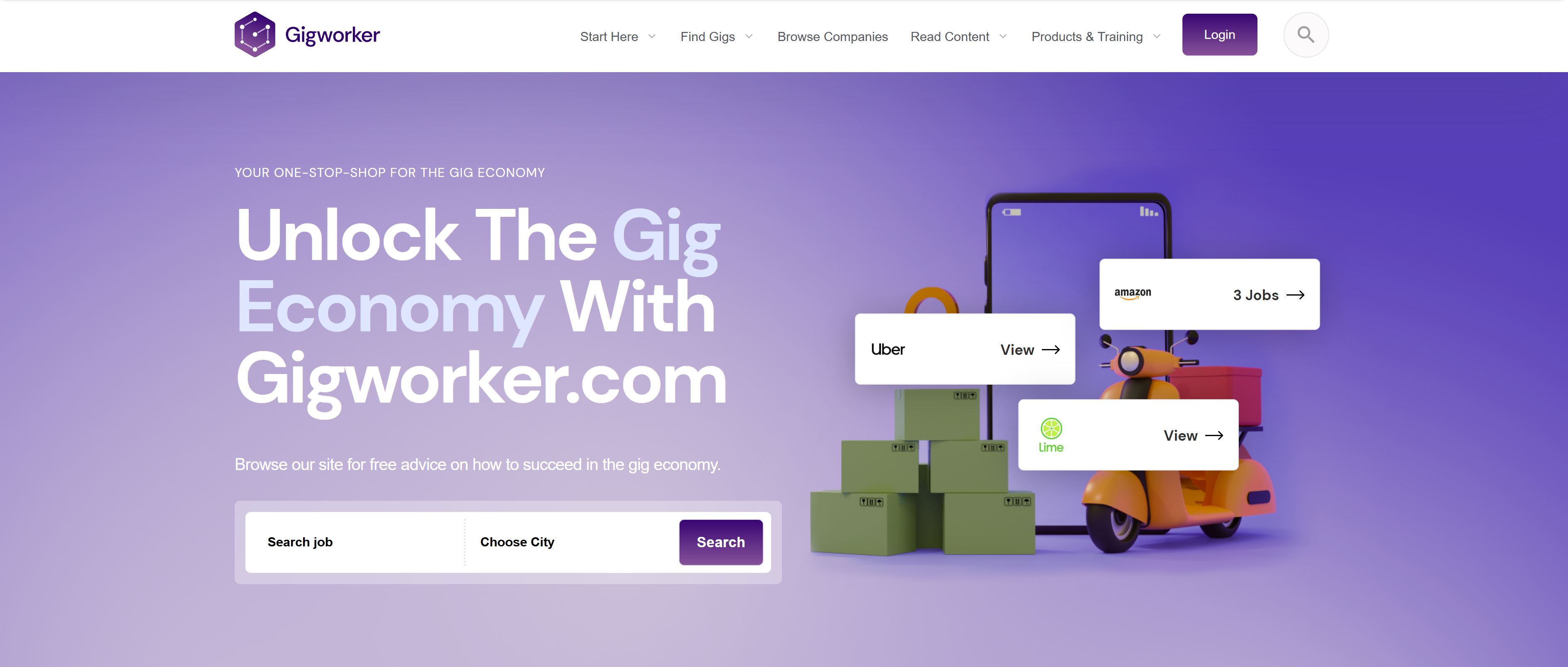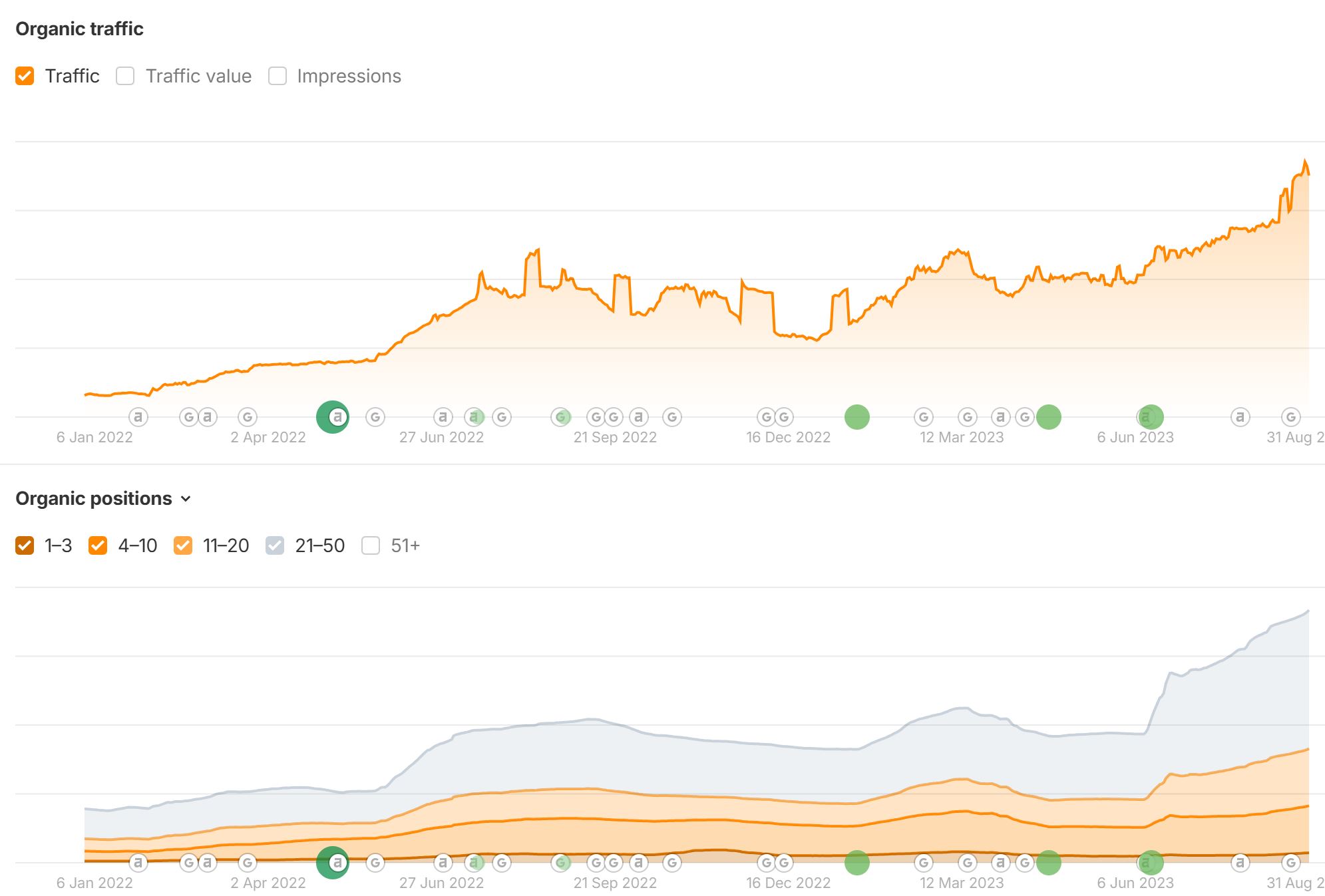
My Enterprise SEO Playbook: 0 to 500K Visits at Gigworker
Learn how my enterprise SEO strategy scaled Gigworker to 500K monthly visitors, six-figure revenue, and established lasting industry-leading authority

Project overview
In early 2019, I had a bold vision: build a resource that would become the essential resource for gig economy workers.
The numbers were clear. By 2027, over 50% of Americans would be earning at least part of their income through gig work.
Yet, there was a huge gap in practical career advice for independent workers. But I wasn't interested in simply launching another blog.
I wanted to build a comprehensive, authoritative resource that could guide gig workers, match them with better opportunities, and earn genuine revenue along the way.
My set ambitious but clear goals from day one:
- achieve 150K monthly visitors in the first year
- scale to 500K monthly visitors by late 2023
- generate stable six-figure annual revenue through strategic monetization
To bring this vision to life, I assembled a 50-person cross-functional team spanning content creation, web development, design, public relations, and data science.
The project's first-year budget reflected the commitment to scale efficiently:
- Content & Outreach: $550K
- Development & UX: $300K
- PR & Brand Building: $100K
- Operations & Tooling: $50K
With clear goals, a robust team structure, and a meticulously planned budget, Gigworker.com was officially underway - and the clock started ticking.
Project execution
Our first sprint, from March to June 2019, focused on creating an MVP, but we took it beyond minimal from the start.
My strategy was simple but strategic. We'd first:
- create an exceptional content experience
- collect insights and data
- use those learnings to shape our future platform
Once we had that data, we'd build on other features and lines of business that would help the site improve as a resource with time.
I kicked things off by assembling a skilled team of designers and developers. Together, we sharpened the concept...
Gigworker would help people find gigs, then provide them with everything they needed to succeed in those roles.
On the tech side, the development team worked directly from detailed Figma designs, clear performance criteria defined by Lighthouse scores, and rigorous acceptance benchmarks.
We built the site intentionally, structuring content into clear topical silos, and adding user-friendly elements that encouraged visitors to explore deeper.
The site felt polished, authoritative, and user-centric from day one.

With the architecture locked in, it was time to ramp up content.
Launching with purpose meant debuting with 100 carefully optimized articles, each designed to serve users and support SEO goals.
I managed a specialized team of freelance writers, two experienced editors, and coordinated closely with an external development agency to ensure everything flowed seamlessly.
We hit our initial target in just a few focused months. Seeing the team deliver on this ambitious timeline was incredibly rewarding.
When we went live, we had complete confidence and immediately started tracking our results closely.
Early Traction & the Link-Building Snowball
I learned in my time building Ridester that we couldn't rank our content without great links and brand authority.
Once we publicly launched, the team executed on an aggressive link building campaign that mainly focused on pitching reporters on HARO.
As a result of our link building efforts, we gained links from hundreds of trusted media outlets like The New York Times, CNBC, and Forbes, just to name a few.

These links helped position our brand as a leader in the gig economy and grow our domain authority, trust, and reputation rapidly.
After the initial surge, we cut back our spend on outreach and re-allocated those dollars to evergreen content.
We leveraged linkable assets such as timelines, quizzes, and calculators that attracted attention from high-value media sources and earned us valuable links organically.
In the end, Gigworker earned an additional 120 authoritative backlinks without a single email sent to get them.
Together, these coordinated efforts quickly began to build momentum, driving Gigworker forward in organic rankings and site authority.
Turning Expertise into Authority (and Revenue)
By late 2019, Gigworker was already surpassing 150K monthly visitors, and the opportunity was clear.
I wanted to position Gigworker as the definitive resource for gig economy workers, building an authoritative SEO moat competitors couldn't easily replicate.

After months of careful research and writing, I launched a comprehensive, 65,000-word book in April 2021.
It distilled actionable insights from our extensive content library and quickly took off.
Within its first year, the book became an Amazon bestseller in the small-business category, selling thousands of copies and further cementing Gigworker’s industry leadership.

This book launch was a carefully orchestrated cross-team initiative:
- Our PR and social teams managed targeted outreach and content promotion.
- Development and analytics teams created dedicated landing pages and tracking systems.
- We executed a detailed, 48-task Kanban board to align all teams toward our launch goals.
- Every major media mention was precisely tracked through GA4 annotations and a dedicated 30-day retargeting funnel.
This comprehensive, collaborative strategy secured coverage from major media outlets like the New York Times, CNBC, Forbes, MSNBC, and Recode.
The resulting surge in visibility drove a significant 28% lift in branded search volume almost overnight.
In short, what started as a strategic effort to build authority transformed Gigworker from "just another gig economy blog" into a widely recognized, authoritative voice in the industry.
Monetizing Traffic (And Learning to Pivot)
With early growth secured, we moved quickly to capitalize on traffic.
I hired a business development team that had one job - achieve a positive ROI to help us recoup the money I spent building out the site.
The team implemented monetization channels such as affiliate partnerships, a curated vendor directory, and initial e-commerce widgets.
The vendor directory alone delivered a substantial impact, boosting our revenue per thousand visitors (RPM) by 22%.
However, during this rapid expansion phase, we made a costly misstep.
The App That Failed
We made a calculated strategic bet to develop a custom app from the ground up - without a solid development framework in place.
We briefly experimented with developing a standalone Ruby-on-Rails application but soon ran into significant setbacks.
This could be an entire case study itself so I won't go into too many details, but it ended up costing us a lot of time and money.
As a result of this failed initiative, we:
- Lost 270 days of valuable development time
- Burned through approximately $160K in development budget
- Missed the opportunity to produce roughly 300 additional content pieces
- Lost focus on the projects providing a positive ROI
After launch, I saw the writing on the wall: the project was draining our resources, morale, and progress.
We quickly convened a same-day triage meeting involving product, finance, and SEO teams.
I decided to cut our losses, reallocate budgets, and refocus our resources on proven, high-impact strategies.
This was a key point in the company's history. It preserved momentum and kept the broader mission on track.
However, the critical lesson became clear: stick to our core strengths and pivot decisively when experiments don't align with strategic goals.
With that lesson learned, we set out to channel our focus into improving the brand while the site grew behind the scenes.
Another Redesign
By late 2020, we had the traffic, data, and authority to help us make informed strategic decisions.
While our Rails app didn't work as intended, it did help us strategize what we were essentially trying to build - an interactive platform that matched users with jobs.
We went back to the drawing board and determined that we could build this in WordPress.
Using our data-driven understanding of what our users wanted, we designed and built V2 of our initial MVP, but this time much more robust.

Like we did before, we built out a Figma design library and spent a great deal of time working our brand into every area of the site.
The result was better than we hoped for. We had a modular architecture that allowed content to scale without causing the readers to get lost in a sea of pagination.
Everything made sense within the user flow and the new design helped elevate our brand from "good" to "great.

And users liked the site, too. Our engagement rates and pages per session skyrocketed and our rankings increased as a result.
Scaling Content Without Scaling Costs
By 2021, we'd proven we could build traffic. But scaling efficiently required smarter systems, not just throwing more money at the same processes.
So, from 2021 to 2023, we set out to dramatically increase content production without inflating budgets.
We didn't simply churn out more articles. Instead, we rebuilt our entire content operation from scratch.
The key focus was leveraging scalable frameworks and SOPs, backed by AI-driven efficiencies to produce higher-quality content faster and at significantly lower costs.
In fact, many of these SOPs and processes were later folded into our agentic content production system.
A few key workflow improvements changed the game:
- We introduced GPT-assisted outlines, dramatically reducing the hours spent on initial content briefs.
- We created an Airtable-driven status board, fully integrated with automated triggers, that simplified collaboration across writing, editing, and publishing teams.
- We implemented a rigorous two-tier editorial QA process, boosting content accuracy and consistency.
- We automated internal-link auditing, improving content structure and SEO effectiveness without manual drudgery.
This workflow wasn't just faster or cheaper, it was transformative. We were producing content better than ever before, in half the time and at a fraction of the cost.
Thanks to these innovations, our content cost per piece dropped by a remarkable 45%, even as our total production surged from around 200 to over 1,200 articles.
And the payoff was huge. By September 2023, we reached our ambitious goal of 500K monthly visits.

But just as we celebrated this success, the SEO landscape shifted dramatically beneath our feet.
Responding to Google's Helpful Content Update
In September 2023, Google's Helpful Content Update (HCU) hit. Overnight, nearly 30% of our traffic vanished.
Instead of panicking, we quickly convened a cross-functional war room within 24 hours, bringing together SEO, data science, and content leads to respond decisively.
First, we conducted an in-depth content audit, scoring every URL based on revenue impact, E-E-A-T criteria, and user engagement metrics.
Then we re-prioritized our entire content roadmap, creating a fresh ICE backlog focused squarely on immediate recovery.
In short order, we executed a series of focused corrective actions:
- Pruned approximately 38% of low-value or underperforming content, tightening our site's quality signal significantly.
- Launched entirely new features - a freelancer directory and a robust job board - to diversify user engagement and revenue opportunities.
- Shipped 214 rewritten or re-optimized pages within the first two months of the update hitting.
Having been around enough of Google's algorithm updates, I knew that it may be a while before we saw results. I just didn't know how long.
We made the updates and then stepped back from the site and let the ranking systems do their thing.
However, I am a persistent individual and decided what better time than now to completely overhaul the site. So that is exactly what I did.

I built rebuilt the platform from the ground up to focus more on service-based features that users would find helpful.
This included features such as being able to browse a list of hundreds of side hustles, to them having the ability to list themselves in a directory of top-rated freelancers.
I also integrated a job board function, which is starting to see signs of heavy engagement. This is a great way to connect gig workers with companies looking to hire for specific tasks.

The site was helpful to users, but after the rebuild and shift in focus, it is now far more helpful than it has even been before.
Project results
Our swift and systematic response eventually paid off, but it did take a while to turn things around. And by a while I mean two years.
In July 2025, we finally saw some results.
I am starting to see positive signs that Google is once more starting to trust the site, recognizing the improvements that I made since last September.
Average session durations are increasing, with visitors now spending over five minutes per visit, signaling a stronger, deeper engagement with the site's improved content and features.
Early data from July 2025 confirms this. Gigworker is clearly back on an upward trajectory, and will hopefully see a full recovery with time.
Enterprise SEO isn't about short-term wins or manipulating algorithms, but intentionally building resilient, lasting business assets through strategic execution.


